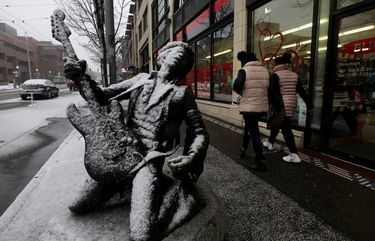Road-maintenance workers are scheduled to salt and plow 24 hours a day, as travelers in the lowland Puget Sound region brace for a rare and possible heavy snowstorm.
Crews can’t be everywhere, so officials call on the public to shovel sidewalks, move their parked cars off arterial streets to help with plowing, and stay home.
“To all the people who moved here in the last few years, and think you’re a great driver in the snow, you’re not,” Seattle Mayor Jenny Durkan declared. “Seattle hills are notoriously difficult, in particular when the snow melts and then freezes.”
The National Weather Service forecast calls for perhaps 1 inch of snow Thursday, before the main snowstorm that could drop 4 to 6 inches Friday afternoon through Saturday morning. However, there’s a 20% chance of more than 8 inches accumulating.
It all hinges on where cold Arctic air from Canada collides with wet Pacific air over Washington state.
Seattle Department of Transportation (SDOT) trucks were already out Wednesday morning to spray de-icing salts on city streets.
Snow-removal teams adhere to a two-tiered map of “gold” mainlines where all lanes are plowed, and “emerald” roads where SDOT plows one lane each direction — in both cases within 12 hours of a snowfall.
SDOT Director Sam Zimbabwe said plans were altered by the closed West Seattle bridge. Trucks can’t whiz back-and-forth as usual on the six-lane bridge, so they’ll focus elsewhere, including transit routes around the low swing bridge, he said.
Highland Park Way Southwest, a long hill with shade trees and damp pavement, is a bridge-detour route many people have never driven during a freeze, so drivers should be extra cautious there, he said.
Another priority will be to plow streets that lead to COVID-19 vaccination sites, Seattle officials said.
Bellevue has bulked up by ordering an extra 300 tons of granular salt, a 10% increase, transportation spokesman David Grant said. Bellevue will deploy 22 road workers and dispatchers. Seven small trucks can plow, salt or sand hard-to-reach roads at Lakemont Highlands and Somerset Hill, and eight dump trucks will patrol the lowlands, Grant said.
A total 21 inches fell during winter 2018-19, the heaviest since 67.5 inches in 1968-69.
The city met and often beat its 12-hour goal to clear mainlines in February 2019 and even responded to urgent hazards.
However, citizens complained about icy light-rail station entrances, and wheelchair ramps. People with limited mobility struggled through mounds of slush in crosswalks. Even some freeway overpasses, such as Denny Way crossing Interstate 5, were slick for days until SDOT responded.
Shoveling snow off Seattle’s 2,600 miles of sidewalks is mostly the responsibility of homeowners and business owners under city law.
This time around, safe-streets advocate Anna Zivarts of Disability Rights Washington is feeling optimistic about both the SDOT and neighborhood sidewalk response.
“Maybe the pandemic has created more awareness of how sidewalks are connecting us in our communities,” Zivarts said. “I see a lot more of the neighbors out walking around, and that makes me hopeful people will be out clearing their sidewalks.”
The Washington State Department of Transportation (WSDOT) has plowed heavy mountain snow all winter, and will simply move to lowlands as needed, said David McCormick, assistant regional administrator. Incident-response trucks will circulate to help stranded motorists in the metro area, he said.
“Keep that snowplow in front of you,” McCormick advises. “If you pass the snowplow, your chances of ending up in a crash go up exponentially.”
King County Metro Transit would shift to snow routes that omit steep slopes. Detour signs are typically inconsistent, but travelers can check Metro’s website beforehand. Bus fare is free when a transit snow emergency is declared.
Metro faces a special challenge because of COVID-19 social-distancing limits, of 12 riders for short buses and 18 for articulated vehicles. Many people, especially lacking homes, will ride to stay warm, causing a dilemma when bus drivers see someone shivering at a bus stop.
Transit drivers will use their best judgment, and can ask supervisors to send additional vehicles for busy routes, spokesman Jeff Switzer said.



The opinions expressed in reader comments are those of the author only and do not reflect the opinions of The Seattle Times.